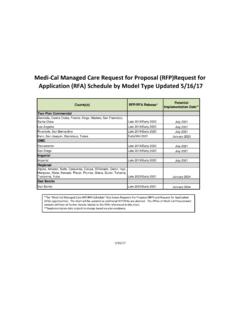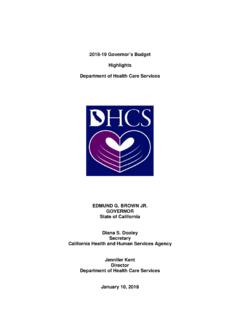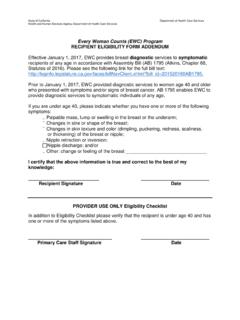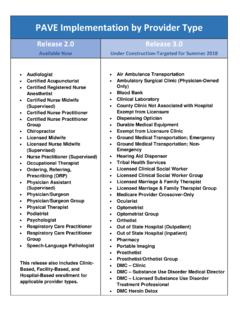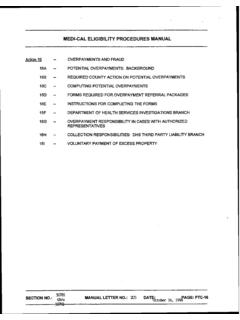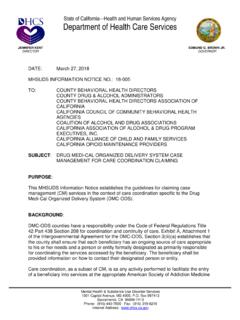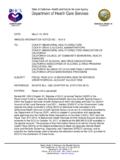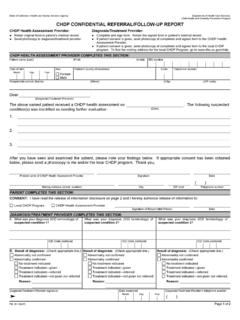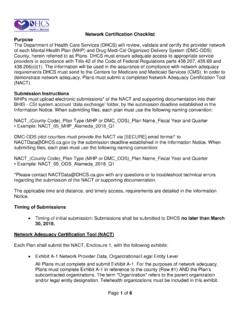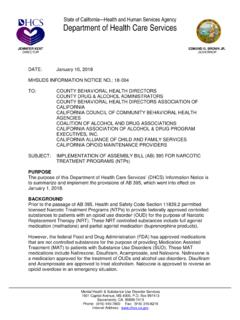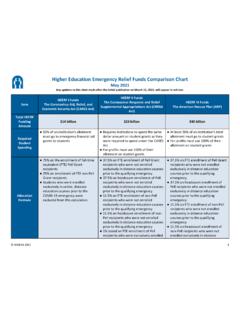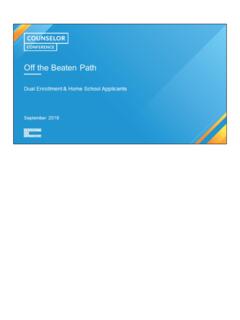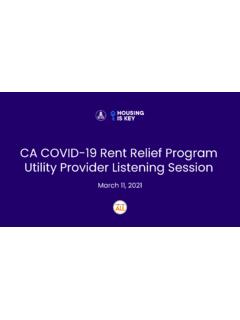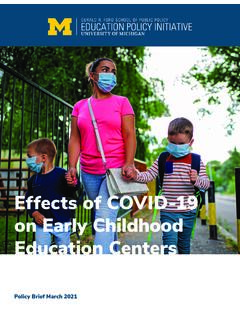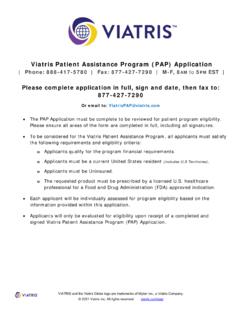Transcription of CalAIM 2021 Proposal Overview - California
1 2021 CalAIM Proposal Overview January 28, 2021. 1. CalAIM Background First released in October 2019 with initial implementation dates planned for January 1, 2021. Extensive CalAIM stakeholder workgroup process (November 2019 . February 2020). 20 in-person workgroup meetings across five workgroups Written and in-person public comment opportunities Due to thetoCOVID-19. Due Public the COVID-19 Health Public Emergency's Health impact Emergency's in theinstate's impact budget and the state's budget health and health care care infrastructure, infrastructure, CalAIM CalAIM .
2 Was put on wasthe hold for putduration on holdoffor2020. the duration of 2020. DHCS has revised the original CalAIM Proposal to reflect learnings from the workgroup process, stakeholder input, ongoing policy development, and new implementation dates 2. CalAIM Guiding Principles Improve the member experience. Deliver person-centered care that meets the behavioral, developmental, physical, long term services and supports and oral health needs of all members. Work to align funding, data reporting, quality and infrastructure to mobilize and incentivize towards common goals.
3 Build a data-driven population health management strategy to achieve full system alignment. Identify and mitigate social determinants of health and reduce disparities and inequities. Drive system transformation that focuses on value and outcomes. Eliminate or reduce variation across counties and plans, while recognizing the importance of local innovation. Support community activation and engagement. Improve the plan and provider experience by reducing administrative burden when possible. Reduce the per-capita cost over time through iterative system transformation.
4 3. CalAIM Goals Identify and manage member risk and need through whole person care approaches and addressing Social Determinants of Health;. Move Medi-Cal to a more consistent and seamless system by reducing complexity and increasing flexibility; and Improve quality outcomes, reduce health disparities, and drive delivery system transformation and innovation through value- based initiatives, modernization of systems and payment reform. 4. CalAIM Components &. Key Changes for 2021. 5. Population Health Management Summary Requires managed care plans (MCPs) to develop and maintain a person-centered population health strategy for addressing member health and health-related social needs across the continuum of care based on data-driven population level assessment, and risk stratification and segmentation.
5 Implementation Date January 1, 2023. 6. Population Health Management Key Changes Clarifies MCPs must partner with community-based providers to address member needs Clarifies that strategies should be developed in coordination with both county behavioral health and public health departments Details added to Assessment of Risk and Need' section on data collection expectations, risk stratification and segmentation, risk tiering, and development of the individual risk assessment tool. Addition of planned learning collaborative topics and continuing areas of policy development.
6 7. Enhanced Care Management Summary A statewide enhanced care management (ECM) benefit that provides a whole- person approach to care that addresses the clinical and non-clinical circumstances of high-need Medi-Cal beneficiaries. The ECM benefit builds on the current Health Homes Program and Whole Person Care Pilots. Implementation Dates January 1, 2022 MCPs in counties with Whole Person Care and/or Health Homes Programs transition aligning target populations July 1, 2022 MCPs in counties with Whole Person Care and/or Health Homes implement additional target populations.
7 MCPs in non-Whole Person Care or Health Homes counties begin implementation of select target populations January 1, 2023 Full implementation of ECM in all counties 8. Enhanced Care Management Key Changes Addition of target population descriptions, developed based on stakeholder feedback (Appendix I). Clarifies that Local Government Agency Targeted Case Management (TCM) benefits will continue (pending CMS. approval). Clarifies that MCPs will be required, with limited exceptions, to contract with existing Health Homes community-based care management entities (CB-CMEs) and Whole Person Care providers.
8 9. In Lieu of Services Summary Proposes a set of 14 in lieu of services' (ILOS) that plans can use to provide health-related services as an alternative or substitute for covered Medi-Cal benefits. ILOS will be integrated with care management for members at high levels of risk and allow plans to address social determinants of health in a way that is cost-effective and consistent with whole person care approached. Managed care plans will be able to add ILOS over time. Implementation Date January 1, 2022. Key Change Revised ILOS menu based on workgroup and stakeholder feedback, including the addition of Asthma Remediation as an ILOS.
9 10. Shared Risk, Shared Savings &. Incentive Payments Summary Incentivizes MCPs to invest in delivery system infrastructure, build care management and in lieu of services capacity, and improve quality performance and measurement reporting that can inform future policy decisions. Implementation Dates Implementation of incentive payments beginning January 1, 2022. Implementation of seniors and persons with disabilities and long-term care blended rate in 2023. Tiered, retrospective model would be available for 2023-2025; prospective model of shared savings/risk to be incorporated via capitation rates in 2026.
10 11. SMI/SED Section 1115 Demonstration Summary Proposes that DHCS pursue the SMI/SED Section 1115 demonstration opportunity, as long as systems are positioned to achieve the required goals and outcomes, including building out a full continuum of care to offer beneficiaries community-based care in the least restrictive setting. County participation would be optional. Implementation Date Proposal to be developed no sooner than July 2022. Key Changes Updates key requirements of Section 1115 demonstration Updates key requirements of Section 1115 demonstration opportunity and list of states that have approved SMI/SED waivers opportunity and list of states that have approved SMI/SED waivers 12.
